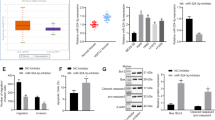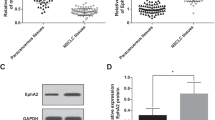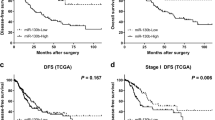Abstract
MicroRNA-155 (miR-155) overexpression is often found in malignancies including lung cancer. The objective of this study is to verify the hypothesis, based on the results of bioinformatics analysis, that miR-155 modulates cellular apoptosis and DNA damage through the regulation of Apaf-1 and is thus involved in the development and progression of lung cancer. First, we measured the expression of miR-155 and the Apaf-1 protein in lung cancer tissues. The results showed that expression of miR-155 was significantly higher in lung cancer tissues than in paracancerous and normal tissues; whereas Apaf-1 expression was lower in the lung cancerous tissues. We then established miR-155-silenced and Apaf-1-overexpressed A549 cell lines by transfection with pMAGic2.0-BIC-siRNA and pcDNA3.1-Apaf-1, respectively. These cell lines were then treated with cisplatin, and apoptosis and DNA damage were assessed, with non-transfected A549 cells used as negative controls. The results showed that, relative to controls, the silencing of miR-155 resulted in elevated expression of the Apaf-1 protein, whereas Apaf-1 mRNA levels remained unchanged. Both the silencing of miR-155 and the overexpression Apaf-1 greatly increased the sensitivity of A549 cells to cisplatin treatment, as evidenced by elevated rates of apoptosis and DNA damage. Furthermore, dual-transfection of A549 cells with miR-155 siRNA and Apaf-1 siRNA resulted in the attenuation of apoptosis and DNA damage. In conclusion, the inhibition of miR-155 can enhance the sensitivity of A549 cells to cisplatin treatment by modulation of cellular apoptosis and DNA damage through an Apaf-1-mediated pathway.
This is a preview of subscription content, access via your institution
Access options
Subscribe to this journal
Receive 12 print issues and online access
$259.00 per year
only $21.58 per issue
Buy this article
- Purchase on Springer Link
- Instant access to full article PDF
Prices may be subject to local taxes which are calculated during checkout





Similar content being viewed by others
References
Bartel DP . MicroRNAs: genomics, biogenesis, mechanism, and function. Cell 2004; 116: 281–297.
Engels BM, Hutvagner G . Principles and effects of microRNA-mediated post-transcriptional gene regulation. Oncogene 2006; 25: 6163–6169.
Griffiths-Jones S, Grocock RJ, van Dongen S, Bateman A, Enright AJ . miRBase: microRNA sequences, targets and gene nomenclature. Nucleic Acids Res 2006; 34: D140–D144.
Han J, Lee Y, Yeom KH, Nam JW, Heo I, Rhee JK et al. Molecular basis for the recognition of primary microRNAs by the Drosha-DGCR8 complex. Cell 2006; 125: 887–901.
Yi R, Qin Y, Macara IG, Cullen BR . Exportin-5 mediates the nuclear export of pre-microRNAs and short hairpin RNAs. Genes Dev 2003; 17: 3011–3016.
Chendrimada TP, Finn KJ, Ji X, Baillat D, Gregory RI, Liebhaber SA et al. MicroRNA silencing through RISC recruitment of eIF6. Nature 2007; 447: 823–828.
Tam W . Identification and characterization of human BIC, a gene on chromosome 21 that encodes a noncoding RNA. Gene 2001; 274: 157–167.
Faraoni I, Antonetti FR, Cardone J, Bonmassar E . miR-155 gene: a typical multifunctional microRNA. Biochim Biophys Acta 2009; 1792: 497–505.
Saito M, Schetter AJ, Mollerup S, Kohno T, Skaug V, Bowman ED et al. The association of microRNA expression with prognosis and progression in early-stage, non-small cell lung adenocarcinoma: a retrospective analysis of three cohorts. Clin Cancer Res 2011; 17: 1875–1882.
Zheng D, Haddadin S, Wang Y, Gu LQ, Perry MC, Freter CE et al. Plasma microRNAs as novel biomarkers for early detection of lung cancer. Int J Clin Exp Pathol 2011; 4: 575–586.
Babar IA, Czochor J, Steinmetz A, Weidhaas JB, Glazer PM, Slack FJ . Inhibition of hypoxia-induced miR-155 radiosensitizes hypoxic lung cancer cells. Cancer Biol Ther 2011; 12: 908–914.
Giaccone G . Clinical perspectives on platinum resistance. Drugs. 2000; 59 (Suppl 4): 9–17 discussion 37–38.
Okouoyo S, Herzer K, Ucur E, Mattern J, Krammer PH, Debatin KM et al. Rescue of death receptor and mitochondrial apoptosis signaling in resistant human NSCLC in vivo. Int J Cancer 2004; 108: 580–587.
Mueller T, Voigt W, Simon H, Fruehauf A, Bulankin A, Grothey A et al. Failure of activation of caspase-9 induces a higher threshold for apoptosis and cisplatin resistance in testicular cancer. Cancer Res 2003; 63: 513–521.
Riedl SJ, Salvesen GS . The apoptosome: signalling platform of cell death. Nat Rev Mol Cell Biol 2007; 8: 405–413.
Taganov KD, Boldin MP, Baltimore D . MicroRNAs and immunity: tiny players in a big field. Immunity 2007; 26: 133–137.
Tili E, Michaille JJ, Cimino A, Costinean S, Dumitru CD, Adair B et al. Modulation of miR-155 and miR-125b levels following lipopolysaccharide/TNF-alpha stimulation and their possible roles in regulating the response to endotoxin shock. J Immunol 2007; 179: 5082–5089.
Yanaihara N, Caplen N, Bowman E, Seike M, Kumamoto K, Yi M et al. Unique microRNA molecular profiles in lung cancer diagnosis and prognosis. Cancer Cell 2006; 9: 189–198.
Raponi M, Dossey L, Jatkoe T, Wu X, Chen G, Fan H et al. MicroRNA classifiers for predicting prognosis of squamous cell lung cancer. Cancer Res 2009; 69: 5776–5783.
Dorsett Y, McBride KM, Jankovic M, Gazumyan A, Thai TH, Robbiani DF et al. MicroRNA-155 suppresses activation-induced cytidine deaminase-mediated Myc-Igh translocation. Immunity 2008; 28: 630–638.
Qin A, Zhou Y, Sheng M, Fei G, Ren T, Xu L . Effects of microRNA-155 on the growth of human lung cancer cell line 95D in vitro. Zhongguo Fei Ai Za Zhi 2011; 14: 575–580.
Reubold TF, Wohlgemuth S, Eschenburg S . Crystal structure of full-length Apaf-1: how the death signal is relayed in the mitochondrial pathway of apoptosis. Structure 2011; 19: 1074–1083.
Zou H, Li Y, Liu X, Wang X . An APAF-1 cytochrome c multimeric complex is a functional apoptosome that activates procaspase-9. J Biol Chem 1999; 274: 11549–11556.
Sancho M, Herrera AE, Gortat A, Carbajo RJ, Pineda-Lucena A, Orzáez M et al. Minocycline inhibits cell death and decreases mutant Huntingtin aggregation by targeting Apaf-1. Hum Mol Genet 2011; 20: 3545–3553.
Mondragón L, Galluzzi L, Mouhamad S, Orzáez M, Vicencio JM, Vitale I et al. A chemical inhibitor of Apaf-1 exerts mitochondrioprotective functions and interferes with the intra-S-phase DNA damage checkpoint. Apoptosis 2009; 14: 182–190.
Shawgo ME, Shelton SN, Robertson JD . Caspase-mediated Bak activation and cytochrome c release during intrinsic apoptotic cell death in Jurkat cells. J Biol Chem 2008; 283: 35532–35538.
Kong W, He L, Coppola M, Guo J, Esposito NN, Coppola D et al. MicroRNA-155 regulates cell survival, growth, and chemosensitivity by targeting FOXO3a in breast cancer. J Biol Chem 2010; 285: 17869–17879.
Koch M, Mollenkopf HJ, Klemm U, Meyer TF . nduction of microRNA-155 is TLR- and type IV secretion system-dependent in macrophages and inhibits DNA-damage induced apoptosis. Proc Natl Acad Sci USA 2012; 109: E1153–E1162.
Crawford N, Chacko AD, Savage KI, McCoy F, Redmond K, Longley DB et al. Platinum resistant cancer cells conserve sensitivity to BH3 domains and obatoclax induced mitochondrial apoptosis. Apoptosis 2011; 16: 311–320.
Wang G, Rong J, Zhou Z, Duo J . Novel gene P28GANK confers multidrug resistance by modulating the expression of MDR-1, Bcl-2 and Bax in osteosarcoma cells. Mol Biol (Mosk) 2010; 44: 1010–1017.
Acknowledgements
This work was supported by the National Natural Science Foundation of China (No.30900660, 81172227).
Author information
Authors and Affiliations
Corresponding authors
Ethics declarations
Competing interests
The authors declare no conflict of interest.
Rights and permissions
About this article
Cite this article
Zang, YS., Zhong, YF., Fang, Z. et al. MiR-155 inhibits the sensitivity of lung cancer cells to cisplatin via negative regulation of Apaf-1 expression. Cancer Gene Ther 19, 773–778 (2012). https://doi.org/10.1038/cgt.2012.60
Received:
Revised:
Accepted:
Published:
Issue Date:
DOI: https://doi.org/10.1038/cgt.2012.60
Keywords
This article is cited by
-
Andrographis modulates cisplatin resistance in lung cancer via miR-155-5p/SIRT1 axis
Functional & Integrative Genomics (2023)
-
Expression profiles, biological functions and clinical significance of circRNAs in bladder cancer
Molecular Cancer (2021)
-
The value of miR-155 as a biomarker for the diagnosis and prognosis of lung cancer: a systematic review with meta-analysis
BMC Cancer (2019)
-
miR-155 in cancer drug resistance and as target for miRNA-based therapeutics
Cancer and Metastasis Reviews (2018)
-
Poly-lactic acid nanoparticles (PLA-NP) promote physiological modifications in lung epithelial cells and are internalized by clathrin-coated pits and lipid rafts
Journal of Nanobiotechnology (2017)



